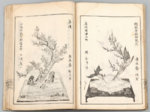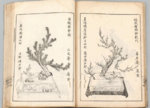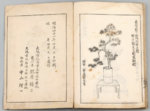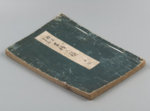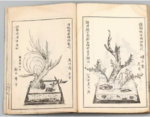You are using an out of date browser. It may not display this or other websites correctly.
You should upgrade or use an alternative browser.
You should upgrade or use an alternative browser.
1800’s Bonsai tree book Japanese
- Thread starter scottc
- Start date
Leo in N E Illinois
The Professor
- Messages
- 11,341
- Reaction score
- 23,293
- USDA Zone
- 5b
Interesting
I recognize Ume and JBP
others are harder to make out.
I recognize Ume and JBP
others are harder to make out.
SizeXtraMedium
Yamadori
That is so cool
bonsaichile
Omono
Really interesting to see the different pots they show and how different they are from the ones we use now. These seem to be like grow boxes, almost: large and shallow. Also, I dont see any root flare in these. It would be interesting to know what the captions say, though
Mike Hennigan
Chumono
Wow, that’s awesome!!! Don’t they know that those conifer branches are supposed to be going downward though? Who taught these guys how to bonsai?! ???
bonsaichile
Omono
I might be interested in the book. What is the exact issue date?
I can have all the text translated. The book is $165 the cost to translate it is $100
Potawatomi13
Imperial Masterpiece
Difference in pots indeed interesting .
.
M. Frary
Bonsai Godzilla
Got to remember.Wow, that’s awesome!!! Don’t they know that those conifer branches are supposed to be going downward though? Who taught these guys how to bonsai?! ???
Those would be examples of what they used back then.
Yamadori almost exclusively.
Naturalistic to the max.
Velodog2
Chumono
Let’s be real here, the trees in these pics are charming and do exude a natural vibe, but by today’s standards they would largely be viewed as quaint attempts, perhaps by beginners. This could make you question what we consider “good” these days in bonsai, but I prefer to think if it as huge progress. It even extends to aspects such as placement of the tree in the pot.
There appears to be very little development of these trees and you even wonder how long they had been in pots or were expected to survive there. As was pointed out before the total lack of root flare or even any evidence of roots at all makes you wonder if that was inaccuracy on the part of the artist or if these were actually maybe literally temporary displays of sticks in pots, because that is what they appear to be.
There appears to be very little development of these trees and you even wonder how long they had been in pots or were expected to survive there. As was pointed out before the total lack of root flare or even any evidence of roots at all makes you wonder if that was inaccuracy on the part of the artist or if these were actually maybe literally temporary displays of sticks in pots, because that is what they appear to be.
cockroach
Chumono
I don't mean to piss on a parade but the writing seems to be Chinese. If I can read a string of 7 characters it is not Japanese.
The last pic gives a date year 41, actually I think it says printed 3 April, 41. This leads me to believe it may be Taiwanese in origin as their year 0 was 1911. Making the book from 1952.
We are currently in year 107年
The adress in the last pic may be a plot in Osaka though.
The last pic gives a date year 41, actually I think it says printed 3 April, 41. This leads me to believe it may be Taiwanese in origin as their year 0 was 1911. Making the book from 1952.
We are currently in year 107年
The adress in the last pic may be a plot in Osaka though.
It says Meiji 41, meaning it’s printed in 1908. @scottc , don’t sell it as 1800 book...I don't mean to piss on a parade but the writing seems to be Chinese. If I can read a string of 7 characters it is not Japanese.
The last pic gives a date year 41, actually I think it says printed 3 April, 41. This leads me to believe it may be Taiwanese in origin as their year 0 was 1911. Making the book from 1952.
We are currently in year 107年
The adress in the last pic may be a plot in Osaka though.
I do think it’s japanese though. They’re probably place names and stuff, can’t read any of it
M. Frary
Bonsai Godzilla
Isnt necessary on yamadori.total lack of root flare or even any evidence of roots
These guys were just collecting naturally stunted trees and potting them up.
Since then the Japanese have taken bonsai to the stylized refined trees you see today.
Velodog2
Chumono
Yeah I realize nebari is optional on yamadori, but odd that there is no sign on any of them of any roots or root flare at all. They honestly look exactly like nothing more than cut off branches stuck in a pot.Isnt necessary on yamadori.
These guys were just collecting naturally stunted trees and potting them up.
Since then the Japanese have taken bonsai to the stylized refined trees you see today.
Leo in N E Illinois
The Professor
- Messages
- 11,341
- Reaction score
- 23,293
- USDA Zone
- 5b
Classical Japanese script, especially before the 1920's was largely the same, 90% or so the same as traditional Chinese script. Since Chinese written characters are essentially pictographic, there are no phonetics associated with the first 4000 or so most commonly used characters, so the Japanese and the Chinese would read identically, The simplified scripts modified to be used for typewriters, movable type for newspapers, and later computer keyboards are more phonetic, and there the language differences are immediate and obvious.
Shinjuku
Mame
This is clearly Japanese, not Chinese. Leo above is correct that in addition to the hiragana script, Japan uses kanji, which is borrowed from China. Many times when reading the Japanese language, there is more kanji than hiragana (or katakana).
The part I’ve circled in blue below says the 41st year of the Meiji period, fourth month, third day - April 3, 1908. A Chinese author would not refer to dates written in the Japanese calendar.
So it’s a very nice find of Japanese art, just written in the very early 20th century.
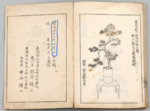
The part I’ve circled in blue below says the 41st year of the Meiji period, fourth month, third day - April 3, 1908. A Chinese author would not refer to dates written in the Japanese calendar.
So it’s a very nice find of Japanese art, just written in the very early 20th century.

scottc
Mame
- Messages
- 114
- Reaction score
- 148
Ahh thank you. 1908 it is. Style is super similar to older but I really on my partner to ID and date stuff. Take a look at my Instagram if your a fan of Japanese art.This is clearly Japanese, not Chinese. Leo above is correct that in addition to the hiragana script, Japan uses kanji, which is borrowed from China. Many times when reading the Japanese language, there is more kanji than hiragana (or katakana).
The part I’ve circled in blue below says the 41st year of the Meiji period, fourth month, third day - April 3, 1908. A Chinese author would not refer to dates written in the Japanese calendar.
So it’s a very nice find of Japanese art, just written in the very early 20th century.
View attachment 213366
scottc
Mame
- Messages
- 114
- Reaction score
- 148
So that has been read now. 1908 it seemsI might be interested in the book. What is the exact issue date?
Similar threads
- Replies
- 10
- Views
- 266

